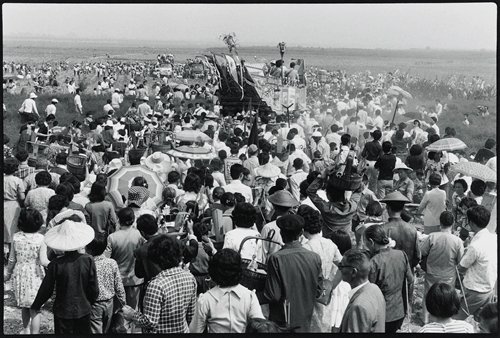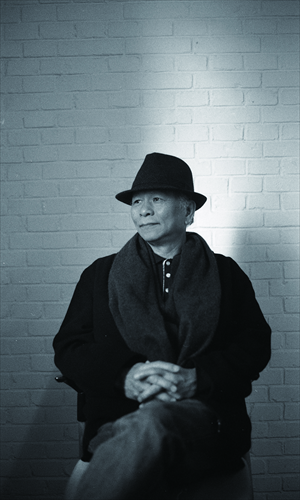Juan I-jong, godfather of Chinese photography, talks about life, society and capturing moments in time

In a photo taken by Juan I-jong in 1978, villagers carry a boat through the streets of Tainan, Taiwan, as part of a ceremony to ward off misfortune. Photo:Courtesy of the Liuli China Museum

Juan I-jong Photo:Courtesy of the Liuli China Museum
In recent years Taiwanese photographer Juan I-jong has been a frequent visitor to the Chinese mainland, where the influence of his books Contemporary Master Photographers and New Contemporary Photography Talent and bilingual Chinese-English magazine Photographers International have earned him the nickname "godfather of Chinese photography."
Born in a village in Yilan county in northeastern Taiwan in 1950, Juan said he feels close to mainlanders since his family can trace their roots back to Nanjing, Fujian Province. Aware of the decrease in mainland travelers to Taiwan over the past few months, Juan revealed his thoughts on the relationship between Taiwan and the mainland.
"Cross-straits relations should not be allowed to worsen. No matter what happens, the two sides should maintain a good relationship," Juan told the Global Times recently in Shanghai, where his solo exhibition Man and Land is being held at the Liuli China Museum until October 30.
He joked that if mainlanders can't go to Taiwan in person, they can always head to his exhibition to see what it's like.
Moments from an era
Man and Land is comprised of a series of 85 photographs taken between 1974-86 in villages around Taiwan. First exhibited in 1987 in Taipei and Paris, the series - which revolves around the four themes of growth, labor, belief and destiny - has earned extensive acclaim from critics ever since.
Chinese artist, writer and critic Chen Danqing commented on the exhibition saying, "What is photography? Why do people take photographs? Mr. Juan's work offers an honest and touching answer."
Originally, Juan had no plans to exhibit the series this year, instead planning on waiting until his 70th birthday in four years to bring them to the public once again. However, Chang Yi, award-winning film director and co-founder of the Liuli China Museum, persuaded the photographer to exhibit the series in Taipei and Shanghai this year.
"I can't wait. I wish every picture could be shared with everyone right now," Chang said in a press release for the exhibition, which opened on Thursday.
Taking advantage of the passenger lines in Taiwan, Juan wandered to places that were still untouched by the wave of modernization that swept Taiwan four decades ago. In Puli township, Nantou county, he took a snapshot of two little brothers running barefoot on a winding path between vast fields of bamboo as mountains loomed in the distance; in Toucheng township, Yilan county, he recorded a man walking through a room filled with empty stools and mourning scrolls left over from a funeral reception; in the Anding district of Tainan, he captured a frozen moment of a time-honored ceremony in which hundreds of villagers paraded a specially-made boat on their shoulders to drive away misfortune and bring prosperity.
Traveling to the farthest corners of Taiwan during its period of martial law (1949-87,) he was often questioned by policemen and soldiers and even detained for entering prohibited areas.
Despite these roadblocks, he experienced a sense of joy the entire time that he compared to the feeling of "falling in love."
"I feel blessed to have captured that era of Taiwan, and I've also revisited those places. Although the scenery, buildings and lifestyles have changed a lot, I can still see the existence of traditional Chinese values," Juan said.
"Kindness, appreciating what you have and generosity are traditional Chinese values that we should keep. I don't exhibit these photos for contemporary audiences out of nostalgia, but to reawaken those traditional virtues that can make life better now and in the future."
In addition to Man and Land, Juan has published nine other series of photographs taken in Taiwan and has shot seven series of works about his overseas experiences in countries such as Armenia, Turkey, Mexico, Morocco and Japan, just to name a few.
Photographer meets world
"It's the goodness in humanity that shows me how to compose a picture, really," Juan, who began teaching himself photography at the age of 22 when he worked for Echo magazine, told the Global Times.
Previously, in his own words, he had been a "narcissist" that expressed himself through writing and abstract painting. However, photography completely changed his view of the world.
"I found that I had never looked at my surroundings carefully, and I felt ashamed that I'd lived in my own world for so long and didn't pay attention to how others think," Juan said, recalling his first experience photographing people on the street.
He soon came to realized that for him photography was about meeting with people, the world and himself. He started to talk to people and listen to their stories, and feel "the sparks" that different people gave off.
Smartphones have changed things a lot. Nowadays social networking platforms are filled to the brim with selfies. In regards to this trend, Juan also extended his concern.
"It seems to me a problem, as I see these selfies and also snapshots of one's pet as narcissistic behavior," Juan told the Global Times.
"Photography is about looking out to discover. A photograph is not only about the photographer, it's also about his/her relationship with society and the era he/she is in. But if you can capture that in one selfie, I'll admire you as well."
Over the past two years, Juan has conducted 19 photography workshops with young people in the Chinese mainland. More recently he launched the first edition of the Juan I-jong Humanity Award for Photography, which encourages Chinese photographers from all around the world to create works that shed light on humanity. The board of judges include Juan, Bryn Campbell, Chen Dan-qing and Lü Nan, author of Trilogy of Men: China's Catholicism & Forgotten People and Four Seasons in Tibet.
Newspaper headline: Snapshot of humanity